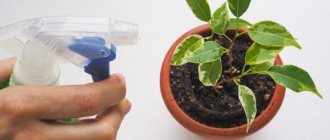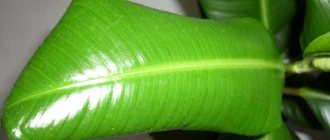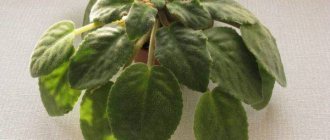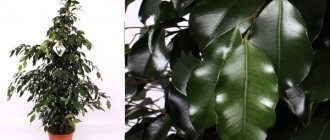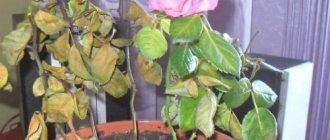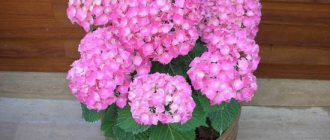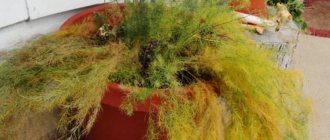Adenium is an unusual tree with a thickening at the base of the trunk (caudex). Its owner has unlimited possibilities for creativity: you can graft 2-3 other varieties with flowers of different shades onto one plant, you can intertwine branches and roots in the most unusual way.
Adenium grows wonderfully at home: blooms, propagates by seeds, cuttings, grafting; very decorative, tolerates shaping well, does not require much space. Caring for it is simple and feasible for every gardener, taking into account the peculiarities of its development.
Adenium flower - description
In appearance, adenium does not look like what a person is used to imagining when thinking about succulents, famous plants loved by many for their ease of care (for example, Crassula, also known as the money tree, belongs to the succulents), but it is true: adenium is a succulent, simply from another genus is woody succulents, kurt family. If you look at the variety of adenium, which is popularly called “lamb”, you will notice the similarity with the same Crassula.
The features of caring for it correspond to the family: a lot of light, warmth, less water.
In the wild, adenium grows in Africa and southern Asia. It is also called “Sabinia rose” or “Desert rose”.
It can look completely different, depending on the species, especially since adenium is bred mainly for beauty. In the wild they reach three meters in height, but domestic species usually do not exceed half a meter or a little more.
What does an adenium flower look like?
As a rule, all adeniums, regardless of variety, share the following visual features:
- A thick, tree-like stem, much like a tree trunk, it is even covered with a rough bark-like tissue, usually gray, white, sometimes greenish.
- Most often, adeniums have a caudex - a thickening at the bottom of the tree-like stem in which the plant accumulates moisture and nutrients. In the wild, it is the caudex that helps the flower survive without moisture for a long time. However, there are varieties without caudex, with thinner stems - they are often used for “braiding”.
- The leaves are bright green, oval, slightly pointed along the edge, glossy, with short stalks, the average length is from eight to fifteen centimeters. Adenium is a deciduous plant, so in poor conditions the leaves turn yellow and fly off.
Due to such features, adenium is often stylized, representing some kind of tree from it: for example, a flowering cherry, bonsai or palm grove.
How the desert rose blooms
It begins to bloom for the first time when the plant is two years old, at first sparsely, but gradually more and more abundantly. With good care they bloom all year round, but even with average flowering lasts several months, unlike other flowers that bloom for a couple of months a year.
What a blooming adenium looks like depends on the variety and variety. They even have different shapes: most often they are bell-shaped, but there are also double adenium, similar to a rose, or with five petals, open like a chamomile. The colors are also different. The most common is pink, but it can also be variegated, red, and white.
How fast it grows
In the first two years of life it is extremely rapid, then growth slows down.
Adenium is poisonous or not
Yes, this is an extremely poisonous plant. Moreover, its danger is that if the poisonous juice of other plants must be licked in order to be poisoned, i.e. If it needs to get on the mucous membranes, then adenium juice only needs to get on the skin to be absorbed and cause symptoms of serious poisoning.
Poisoning, if not treated in time, can even lead to death; it is not just a day of nausea and diarrhea.
Adenium also releases toxic substances into the air, so it is not recommended for people with respiratory diseases to have it. And if you have one, keep it away from children and animals.
Adenium in nature: photo
Crooked leaves
They are often found in adeniums.
This is not always a sign of pathology. If the plant has just woken up, the first leaves released may be exactly like this. They are often seen on adapting grafts. New leaves on an imported graft
This defect can also be caused by uneven watering - long drying periods, alternating with flooding.
And the last option is a genetic mutation, there’s nothing you can do about it.
How to care for Adenium at home
Proper care is the most important thing when you get yourself a green pet, because all diseases and most pests appear precisely due to lack of care. Below you will read what conditions need to be provided for your new green friend.
What to do after purchase
Do not hurry. Having brought adenium into the house, you do not need to replant it immediately - let it sit for a couple of weeks and adapt to the new climate. This is especially true for flowers that have survived delivery from another country (adeniums are most often ordered from Asia, where they are more common), because they:
- firstly, they are exhausted by a long move, and the stress of the transfer can have a bad effect on them;
- secondly, Asian adeniums are often infected with viruses, and in two to three weeks you will be convinced that your flower is completely healthy.
At the same time, it is advisable to keep it in quarantine, separate from other plants, if you have them, so that an accidental “pest exchange” does not occur.
After the quarantine period has expired, the adenium can be transplanted and placed in its rightful place. It is advisable to clean it thoroughly first so as not to create a breeding ground for pests, such as spider mites.
Lighting
Abundantly, at least twelve to sixteen hours a day. Place the flower on a well-lit windowsill. It tolerates direct sunlight well (if it is an adult plant and it has not just come out of winter). In this case, you need to constantly turn the plant so that it receives light from all sides, because it stretches towards the sun.
If you want it to bloom in winter, you will have to use additional light sources.
Content temperature
High, 27-35 degrees, feels comfortable in heat up to 40 degrees, but prolonged cold (18-20 degrees and below) already has a detrimental effect: the flower loses leaves, sheds buds, freezes, and goes into hibernation.
Humidity
Adenium easily tolerates low humidity and needs higher humidity only when it blooms. In general, you don’t have to worry about this: you don’t need to spray the flower, just water it.
The exception is abnormal heat (38+ degrees), then spraying will be required.
Watering
Depends on several factors.
- If adenium blooms, and especially if it is very hot (about 40 degrees), then it is necessary to keep the soil a little moist all the time, but without stagnating moisture inside.
- The frequency of watering depends on the thickness of the trunk and the size of the root system of the flower, because it retains moisture in the roots and trunk. If the trunk is thick and the pot is large (that is, the adenium has room to develop its root system), it is enough to water once every two weeks when it blooms, and less often when it does not. If the trunk and slides are small, then more often.
- If the weather is cool, then watering is reduced even more (small plants - once a month, large ones - once every month and a half) to prevent rotting of the roots. In winter - as rarely as possible, only on sunny days.
Fertilizer and feeding
They are fed only during the flowering period, once or twice a month, with complex fertilizers with a predominance of phosphorus and potassium.
Viral spotting - mosaic virus
Many grafted varietal adeniums that came from Asian nurseries are infected with this infection. Its main manifestation is spotted, sometimes crooked leaves. Some people think they are ugly, some people even like them. But most importantly, the virus does not pose a danger to the plant itself. There is an opinion that nurseries deliberately infect the grafts with viral spotting in order to obtain unique variegated flowers. But there is no exact data.
If living conditions worsen, the infection can suppress the immune system of adenium.
There is no cure, only proper care will suppress the virus so that it goes into a state of deep sleep.
| Mosaic on a grafted plant from Asia |
|
Pruning and shaping Adenium
It is carried out not only for the sake of aesthetic beauty, but also for the health of the plant: pruning is necessary for a lush, healthy crown to help the formation of new leaves and buds.
When to prune
The optimal time of year for pruning is spring and early summer. In general, the reason for pruning is either the lack of flowering (pruning helps the plant to bloom), or formation for aesthetic purposes, or rejuvenation of the plant.
Rejuvenation, i.e. removal of old branches that no longer bloom and spoil the appearance is carried out every two years, combined with replanting.
The diseased parts are also cut off, and over time, the adenium develops a large, heavy root system, and it is cut off to make it easier to handle the flower.
Formation of adenium at home step by step
Ideally, formation is carried out in early to mid-spring, with the air temperature in the room not exceeding 25 degrees.
You will need the following tools: warm water, alcohol, hand pruners or scissors, soap, disposable gloves.
Step-by-step instruction:
- Wear gloves: adenium is poisonous and it is dangerous to touch it with bare skin.
- Wash the plant with warm water.
- Trim thin stems.
- Then trim stems that are too soft, twisted, leafless, inward growing, or damaged so that they do not rub against each other.
- This was pruning for the purpose of recovery. Next, you can carry out aesthetic pruning: give the crown the look you like.
- Throw away your gloves.
After formation, there should be a plant that completely suits you, so that there are no diseased shoots or ones that stand out from the overall composition from an aesthetic point of view.
After pruning, adenium produces a lot of juice. You don’t need to do anything about it, it will go away on its own, just don’t let your pets or family members touch this juice.
If you cut off diseased parts, then after each cutting movement you need to disinfect the tool and wipe it with alcohol so as not to spread the infection further.
Bonsai
A real bonsai is a real tree that was supposed to be large (pine, oak, ash), but its root system was formed in such a way that it grew as an exact copy of its fellow species, but miniature. Adenium does not imply this, but its appearance can easily make it look like a bonsai.
To do this, you need to trim the lower shoots, forming the apical crown, and pinch it regularly, from a very early age, so that it forms lush. Also, pinching helps to expand the trunk too.
Plus, it is necessary to form a beautiful crown from an aesthetic point of view, so that it looks as much like a bonsai as possible and you like it.
Also keep in mind that not all varieties of adenium are suitable for bonsai: there are multi-trunked and thin-trunked ones, but they are not suitable.
Common Pests
Pests attack adenium infrequently, but there is always a risk of insect damage. The most frequently encountered pests are described in the table.
Table - Adenium pests
| Insect | Signs of defeat | Way to fight |
| Root mealybug | — Stopping growth; - faded foliage; - yellowing of leaves; - leaves wrinkle | — Three-fold treatment of the soil with the preparations “Aktara”, “Confidor”; - washing the roots in very warm water |
| Mealybug | - Waxy, cotton wool-like coating; - sugary discharge | — Treatment with soap solution; — spraying with preparations “Aktara”, “Fitoverm” |
| Spider mite | - Fading leaves; - yellow dots on the leaves; - barely noticeable cobweb | — Spraying with Floramait, Masai; - increase in air humidity |
In reviews, experienced flower growers write that a single treatment of adenium with chemicals is not enough.
Even if pests are not detected externally, it is necessary to re-treat after a week. Since you need to carefully care for adenium, this flower is not very suitable for busy people and novice gardeners. When growing adenium, you must strictly adhere to the rules of care and have at least basic experience in shaping.
Bloom
Adenium is not only a beautiful crown, but also bright, attractive flowers. Here you will learn what to do to make it delight you with flowering.
When does adenium bloom at home?
With good care, including artificial lighting during periods when night is longer than day, it can bloom all year. Without such care it blooms from March to September.
How long does it bloom?
Six to seven months or all year round.
Why does adenium not bloom at home?
Perhaps it is still too young to flower: the first flowering begins only in the third or fourth year of life. If it is mature, but does not bloom, then this is usually due to care errors, namely:
- Pot too big. In this case, the adenium begins to fatten, that is, to form a root system in order to eat more nutrients, but does not bloom. Sometimes this is done deliberately in order to form a large caudex.
- Mistakes with the soil: too dense, tends to retain moisture for a long time (this causes the roots to rot), with high acidity.
- Check the caudex. It should be hard. If it is soft, springy, there are two probable reasons, and they are opposite to each other.
First: lack of moisture (then you need to place the adenium in river sand and organize watering through the wick).
Second: overflow. A soft caudex in this case means rotting of the roots. It is necessary to remove the rotten parts and replant the flower, while reducing watering.
- Inspect the plant for pests.
- An overdose of nitrogen fertilizers has the same effect as a pot that is too big.
- There has been no pruning for a long time.
- Lack of lighting. As a rule, in order for adenium to bloom, an additional light source is needed so that it receives at least twelve hours of light per day.
- Hypothermia.
- It did not go to winter, therefore, it has exhausted its strength for flowering.
How to make adenium bloom
Actually, review the care, eliminate the errors listed above, conduct an inspection to see if there are any diseases (for example, pests or rot).
Small leaves
May be a consequence of frequent drying of the soil. Or the root system suffers due to the density of the substrate. If there are no problems with this, or you have corrected everything, but the plant continues to produce small leaves, it may be due to a lack of nitrogen. Or, alternatively, it is a genetic trait or mutation.
Genetically small leaves, does not grow roots, and the adenium itself is dwarf
Reproduction
If you are fascinated by these beautiful, unusual flowers, then sooner or later you will want to try to get a collection. Therefore, here you will read about how propagation by cuttings is carried out at home, how to grow from seeds (at home, of course, too), and how to pollinate at home.
Preparing for transplant
Please note that when propagating some of the methods you will read about below, you will need to cut off part of the plant. That is, you will have to come into contact with its juice. The juice is poisonous and penetrates the body even through the skin, so do not forget to use gloves, and if you have respiratory diseases, then also a mask.
In order to cut off a part of a plant (secateurs, knife, scissors) you need very sharp ones, so that you can cut, for example, a cutting, and not break it off, because otherwise an infection can get into the flower through the cut. You will also need alcohol or hydrogen peroxide to disinfect the instruments, and crushed activated carbon to sprinkle on the cut - this is also needed for disinfection.
Cuttings
The easiest way. It is best to carry out cuttings in the summer, because then it is easiest to provide the adenium with good conditions (abundant sunlight, warm air) so that the cuttings grow better.
The sequence of actions is as follows:
- Two days before the intended transplant, water the adenium.
- Select a cutting. You will need to choose a cutting with the following parameters: 10-15 cm in length, diameter - at least a centimeter.
- Separate the cutting.
- Place it in the fungicide solution for two hours.
- Then make a cross-shaped notch on the cut of the cutting and apply a root growth stimulator to the lower part and cut.
- Leave the cutting for a week to dry.
- Prepare the soil. It should consist of one part peat moss and one part perlite. You can buy ready-made ones for Crasulas.
- Root the cutting, deepening it two to three centimeters.
- In a month, the seedling will give roots, it can be transplanted and cared for like an ordinary adult adenium.
Please note that such a seedling will not have a caudex, that is, it will not be suitable for stylizing as a bonsai, for example, but you can use the “braiding” technique.
By layering
A more reliable method is essentially the same cuttings, but with minor features.
What should be done:
- Choose a long shoot that extends beyond the edges of the pot.
- Make a shallow incision near the drop site. Place a container with soil for the cutting nearby.
- Dig the cutting there and press it with something (you can use a hairpin).
- Constantly moisten the substrate, but do not overfill it so that the water does not stagnate.
The cuttings will take root in two to three months. Then it can be separated and cared for like an adult plant.
Such cuttings are also carried out in the summer to provide the cuttings with good conditions: at low temperatures and high humidity, it will rot.
Seeds
- First you will need to prepare the soil. Its composition should include half raising agents (sand, charcoal, perlite) and half cactus soil, because it does not become denser after watering, which is good for plants with aerial roots. It is better to use charcoal as a leavening agent, because it also disinfects the soil.
- You will also need plastic film or glass to create a greenhouse for the seedlings.
- Suitable conditions for seedlings: hot air (30-35 degrees, if there are no conditions for such a temperature to be constant and naturally, from the sun - use heating), watering - moderate, at least sixteen hours of light every day. For this reason, it is best to sow adenium in the summer, but even then additional tools may be needed, for example, for heating.
- There is no need to soak the seeds, just plant them in the ground (with depth).
- Water moderately to keep the soil moist but not stagnant.
- If everything is done correctly, the seeds will hatch in three to five days. Maximum - in two weeks.
- When all the seeds have hatched, you can remove the heating and place the container with the seeds on the window, where they will receive a lot of light. It is advisable to have a window with blinds or curtains, because the light should be abundant, but diffused, so as not to burn tender young plants.
- The greenhouse must be ventilated daily, a little longer each time. After two weeks, the greenhouse is completely removed.
- It will be possible to feed for the first time in two months. The fertilizer should contain phosphorus, potassium and nitrogen.
- When the seedling has two leaves of its own, it is transplanted into a personal pot.
Pollination of adenium at home
It is much easier to buy seeds. But you can also try to get them yourself, but this is a rather labor-intensive process that requires an understanding of the structure of the flower and finger dexterity. You will need:
- Two plants - maternal and paternal. Seeds will ripen on the mother's side, and from the father's side you will take pollen for pollination (you can cross-pollinate).
- Both plants must be strong, healthy, strong, because otherwise pollination will take all their strength, and you will not only not get seeds, but also lose “parents”.
- Adenium will not survive self-pollination: the seeds will not be viable. But you can try to transfer pollen not from one plant to another, but from one flower to another flower of the same plant.
- A brush or toothpick, jewelry scissors, tweezers, possibly a magnifying glass.
- Fertilizer with phosphorus, nitrogen and potassium to support the mother plant.
It is advisable to pollinate in the summer, in the first half of the day, but if you have bright artificial lighting, the season is not important.
What should be done:
- Choose a flower from which you will take pollen. It must be no older than three days.
- Separate one petal from the “father” flower and from the “mother” flower, because you will need to perform operations on the stamens, and they are located deep in the inflorescence due to their bell-shaped shape.
- Gently pull off the stamens with tweezers to expose the pollen sac. Collect it with a damp brush.
- On the mother plant, you need to tear off the scales that protect it; the pistil is located in the very depths, at the very base of the inflorescence. Apply pollen to the base of the pistil.
After a few days, embryos will form. If they turn red and increase in size, it means you did everything right, the flower is fertilized.
Next you need to wait for the formation of seed pods. This will happen in two to three months. When the pod ripens, it will begin to crack - at this moment it must be immediately tied with some kind of cord to prevent it from bursting.
Next, you need to open the pod yourself and collect the seeds. There can be from ten to hundreds of them - depending on the adenium genes.
The last step is to dry them so they don’t get moldy and put them in a bag.
And now about vaccinations
The grafting of mini adenium onto arabicum is very interesting. I do the vaccinations according to the method of the famous adenium grower Zhamyan Nimaev - “under the drill”. This is a very simple and effective method. A round hole is drilled into the rootstock (or made with any convenient sharp object) and a scion cutting is inserted into it. The grafting site is covered with grafting tape. I place the graft in greenhouse conditions. I cover it with a jar or put a transparent plastic bag on it and ventilate it periodically. Usually after 2-3 weeks the vaccination takes root. It is better to do this in spring and summer, during the time of active growth.
| Vaccinations are secured with a special vaccination tape |
Adenium transplant
Replanting is a fairly common process, but an inexperienced gardener is faced with the question of how to replant correctly and not harm the flower in any way, because it is, after all, stressful. The sequence of steps for transplantation is simple:
- Prepare a new pot and soil. Fill the pot halfway; do not forget to place a two-centimeter layer of drainage on the bottom.
- Wear gloves: adenium is poisonous and it is dangerous to come into contact with open skin, especially if you need to trim the roots.
- Carefully remove the plant from the pot.
- Clean the roots, you can rinse under running water.
- Inspect the root system: is there any rot? Also inspect the lower parts of the leaves, which are usually not visible to the eye: this is where pests, such as aphids, often hide.
- If you notice rotten or dried roots, it is recommended to remove them. If you notice pests, remove them, rinse the plant under running water, and immediately after replanting, treat with an appropriate preparation for your type of pest.
- If everything is in order, then you can replant. Place the plant in the center of the pot and fill in the remaining soil. There is no need to crush: the roots need air. Also, you should not decorate the soil, put something on top of it (this is sometimes done when they want to form adenium in the bonsai style) - this interferes with its “breathing”.
- Watering after replanting should be done no earlier than two days later, because the roots, being under stress from replanting, can easily rot.
When and how often to replant
A young plant (up to about two years old) is replanted no more than twice a year: in winter and summer. The reason for this is that the flower grows very quickly, and its pot quickly becomes small.
After two years, they are replanted once a year, preferably in early spring, so that the plant does not waste growth time adapting after replanting.
Priming
Neutral acidity, sterile, loose, because adenium is a plant with aerial roots, and the roots need to provide an influx of oxygen. If you are going to make the soil yourself, then add part of the peat and part of the river sand (it will act as a loosening agent for the soil).
A drainage layer is also necessary - expanded clay, crushed brick - because adenium is afraid of overflow, and drainage protects against it.
By the way, the question “how to increase the adenium caudex” (“grow your butt,” as they also say) will be answered by the earth. It is necessary to use poor soil without nutrients, and provide nutrients with the help of fertilizers, so that the adenium gains them “for future use”, accordingly, increasing the caudex.
Another way: place the nutritious parts of the soil (for example, humus) along the edges, closer to the sides of the pot, so that the roots are forced to reach towards them. But keep in mind that such machinations usually lead to “fatification,” that is, the plant will actively invest in the development of the root system, but will not bloom.
Pot
A regular plastic pot will do. Ceramics are undesirable because they get very hot in the summer and, on the contrary, cool down in the winter, which causes rotting of the root system.
If you are growing desert flowers for the first time, then it is advisable to purchase a pot with transparent walls: adenium is afraid of overflowing, it needs to be watered only when the earthen ball is completely dry, and if it is in a pot with transparent walls, it is much easier to monitor the drying of the soil.
Chemical burn
Formed as a result of an overdose of fertilizers. It appears as yellow or brown stains in different parts of the leaves, often with clear edges.
There is no specific treatment, but in some cases a transplant may be required. Use fertilizer doses that are half that recommended on the package. Especially if you are using the drug for the first time. This reaction occurs to both organic matter and mineral fertilizer.
|
|
Another way to get a chemical burn is to use spraying agents: foliar fertilizers, phytotoxic insecticides. The cause may be either an overdose or simply intolerance to the active substance.
There is also a combination of burns when you spray plants in the hottest sun. In this case, small specks appear, similar to traces of pest bites. In principle, adenium does not need foliar feeding, and it is better not to do it thoughtlessly.
Adenium diseases and their treatment
Diseases
- Root rot (also affects caudex)
Symptoms: leaves turn yellow, the caudex becomes soft and changes color, leaves stop growing.
Reasons: too low a temperature around the plant combined with waterlogging of the soil. Such conditions have a bad effect even on people (which is why many people get sick in the off-season), let alone plants.
What to do: remove the plant from the pot and inspect the roots. It is necessary to carefully cut off the rotten parts, leaving only healthy roots. It is important to do this with sharp scissors so that you cut the root and not break it off. The cut will soon darken - this is normal, the juice just came into contact with air and oxidized. You don't need to do anything about it.
The next step is to treat the sections with three percent hydrogen peroxide and leave for half an hour - let them dry. Then it is necessary to treat the sections with an antibacterial medicine, mixing it with fungicides, and then leave to dry in a warm and dry place for several days.
Drying takes up to a week if the rot is severe. When you find that the edges of the cuts have hardened and the root system looks healthy and not damaged, you can plant the plant back in the pot, in a dry, clean, preferably disinfected substrate.
After treatment, the plant must be placed in a dry, warm place, with moderate watering.
- Drying branches
Symptoms: the branch dries out, turns yellow, the affected area looks like the brown bark of an ordinary tree, a dark green hard cap appears at the end of the branch.
What to do: there are several options to solve the problem:
- Cut the damaged branch and then coat it all with ampicillin, then place the flower where it will receive plenty of sunlight. This will help stop drying out.
- Treat with drugs called “Fundazol” and “Tetracycline”, provide the adenium with bright, abundant sunlight.
- Folk remedy: make an incision below the dried area and treat it with brilliant green or hydrogen peroxide.
- Treat the plant with fungicides.
- Round spots.
Symptoms: brown round spots on the leaves, then on the caudex.
Causes: This is a fungal disease, usually caused by excess moisture.
What to do: treat the plant with fungicides (it is also advisable to treat it as a preventive measure at least once a month, especially in the summer, even if the adenium is not sick yet).
- Leaf necrosis
Symptoms: yellowing of leaf edges.
Causes: Not enough sunlight or nutrients. Figuratively speaking, the plant thinks that autumn has come and sheds its leaves. It will also reset them if you didn’t take care of artificial lighting in the fall.
What to do: provide artificial or natural bright lighting, reduce watering (water only when the earthen ball is completely dry) so as not to flood the plant and not provoke the appearance of fungi.
- Small leaves
Reasons: lack of watering; too dense soil, which is unacceptable for a plant with aerial roots, lack of nitrogen, or a feature of this particular flower.
What to do: try to correct the factors described above: water more often, replace the soil with a lighter one and loosen it, introduce nitrogen fertilizing.
- Crooked leaves
Symptoms: twisted, wavy, twisted leaves.
Reasons: such leaves often appear when the plant has just come out of winter, this is normal. This also often happens after vaccination has been carried out.
Among care errors, this effect occurs due to uneven watering, when the plant is sometimes not watered at all, sometimes it is flooded, as if trying to compensate for a long absence. You can't do that.
Or is it a genetic mutation.
What to do: Review your watering schedule. If everything is fine with him, accept it and wait.
- Mosaic virus
Symptoms: yellow spots on the leaves, their curvature.
Causes: This is a viral disease, its occurrence is pure luck.
What to do: follow the rules of care. There is no cure, but mosaic virus is not dangerous for adenium if good conditions are met. If they are bad, then the virus suppresses the adenium’s immunity.
- Sunburn
Symptoms: white sandy spots on any part of the plant, similar to a thick layer of light dust.
Reasons: adenium is truly a desert rose, but if suddenly exposed to the sun after wintering, it can, out of habit, get burned by too bright rays.
What to do: remove adenium from the sun and wait, the desert rose will cope with the burn itself.
- Chemical burn
Symptoms: yellow-brown spots on the leaves that really look like burns, as if someone had burned the plant with fire.
Causes: overdose of fertilizers.
What to do: replant in clean soil and halve the dosage of fertilizers, especially when introducing it for the first time.
Adenium pests
- Spider mite
Symptoms: the leaves have lost their shine, light specks have appeared on them, then they will grow to light spots, then the leaves will turn yellow and fall off. You may also notice a characteristic coating, similar to a thin cobweb, usually on the lower parts of the plant.
Why: as a rule, lack of watering, too dry and warm air around.
What to do: rinse the adenium under running water, wipe the pot, thoroughly wash the place where the flower stood: wipe the windowsill, window, shelves around, blinds with soap, if there were curtains hanging nearby - they are sent to the wash, because spider mites or its larvae.
If your steppe rose blooms, alas, the buds will have to be trimmed. Then you need to treat the adenium with an anti-tick drug three to four times (with breaks of three to five days), preferably from a spray bottle and generously. It is better to treat each time with a new drug, because spider mites easily adapt to toxic substances and develop immunity.
- Aphid.
Symptoms: aphids are usually visible visually (large light green bugs, usually located on the underside of the leaves), but in addition to this, the leaves also curl.
Reasons: pure luck. Most likely, the aphids flew onto the adenium from another plant.
What to do: it’s quite easy to fight aphids; just treat adenium with insecticides a couple of times.
- Mealybug
Symptoms: cotton wool-like coating, leaf deformation. Most often it appears in November-December and on young plants.
What to do: replant the adenium, because the mealybug lays eggs in the substrate; then wipe the plant with a cloth soaked in a solution of soap and alcohol (water, soap, alcohol, preferably laundry soap), and at the same time remove all the insects you find. Buds and damaged leaves will have to be removed. Then treat with insecticides three times with a break of a week.
- Whitefly
Symptoms: visually noticeable - many small white butterflies. The danger of this pest is that it lives on the flower unnoticed for a long time, and you can only notice it when there are already a lot of pests. Because of whiteflies, adenium grows more slowly or stops growing altogether, and whiteflies also provoke the appearance of fungi.
What to do: thoroughly wash the adenium with soapy water, thoroughly wash all surfaces around it, and treat it with insecticides three to four times.
- Shield.
Symptoms: green spots on the leaves, which then grow along the entire central vein of the leaf, sticky coating on the leaves, due to which fungus easily appears.
What to do: provide the adenium with a warm and dry microclimate, remove all pests with wet wipes or other devices (cotton pads can be moistened with soapy water), wipe all surfaces around the flower, treat the plant with insecticides three to four times at an interval of three days.
Growing difficulties
Loss of decorativeness, yellowing, and falling leaves are not always associated with diseases. Much more often the reason is hidden in improper care. The table describes the most common difficulties in growing adenium. Problems are solved by adjusting care.
Table - Problems of growing adenium
| Problem | Possible reasons |
| Crooked leaves | — Uneven watering, alternating drying and flooding |
| The tips of the leaves dry out | — Air is too dry; — not enough moisture; - a sharp change in conditions of detention; - excess sun |
| Small leaves | — Frequent drying out of the soil; - dense soil; - lack of nitrogen |
| The leaves are turning yellow | — Problems with roots; - lack or excess of moisture |
| Leaf wilt | — Stuffy room; - excess moisture |
| Adenium leaves are falling | — The onset of a period of rest; - low temperature and damp soil |
| Brown spots | — Sunburn |
| Slow growth | — Lack of nutrition; - little light during the dormant period |
| Rapid fading of flowers | - Heat; — low air humidity |
| Reddish foliage | — Lack of copper |
Popular varieties of Adeniums with names and photos
Adeniums come in different varieties and are suitable for different decorative solutions. Here are some popular varieties.
Obesum (Adenium Obesum)
The peculiarity of this variety: with it you can simultaneously form a tree with a crown and “braid a pigtail” at the bottom. The flowers are large, white-purple, elongated branches.
Black Swamp
An unusual variety: if most adeniums are pink or red, then this variety is black, rich, deep in color, the leaves shine through crimson in the light.
Golden Years
Luxurious, rich variety. The buds are shaped like lush roses, two-colored: purple and gold smoothly blend into each other, reminiscent of royal luxury.
Double Star
This variety is called a star because of its shape, which really resembles a star. The colors of the buds vary, most often various combinations of white, pink and red, but the petals are always white in the middle and red or pink at the edges.
Fat
This is the name of the wild variety of adenium, the same one from which all other varieties came. Compared to its decorative counterparts, it can look quite inconspicuous.
Arabicum (Adenium Arabicum)
This variety is prone to forming a very thick trunk, but the apical stems are quite thin, the foliage is bright green, with small, elastic, rounded leaves.
Variegated
A variety whose distinctive feature is two-colored, variegated leaves (namely leaves, not buds). As a rule, they are green-yellow, sometimes with specks. Please note that such varieties require more light, and adenium itself is generally light-loving.
Anouk (Adenium Anouk)
A bright, attractive variety, not prone to forming a thick trunk, but it has very bright, pink-purple star-shaped inflorescences.
Socotranum (Adenium Socotranum)
This variety is not grown for the sake of lush flowering, but rather for its unusual shape: a very thick trunk (usually even larger than a modest crown), long branches spread out in different directions - it looks very unusual.
Somali (Adenium Somalense)
One of the few varieties characterized by a small number of flowers. Instead of a lush flowering crown, there are several large white and pink inflorescences. It also has unusual leaves - not round, like most varieties, but elongated.

